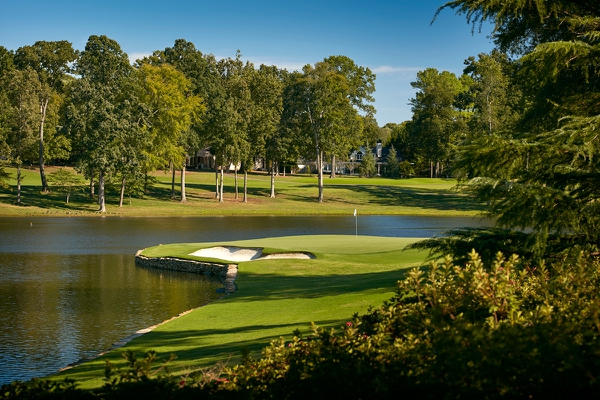Take a hole-by-hole tour of the Quail Hollow Club in Charlotte, North Carolina, which hosts the 2017 PGA Championship.
Hole 1: Par 4 – 524 Yards
Lengthened during the most recent course additions in the summer of 2016, the first hole is now, in essence, a combination of the former first and second holes. A long left to right tee shot will place players atop an elevated landing zone and beyond the edge of the dogleg. From here, players will face a mid- to long-iron for their second to a small and undulating green protected by three large bunkers.
Hole 2: Par 4 – 452 Yards
Through the years, this long dogleg left has changed several times. First, it was made shorter and then it was returned to the original length, which added back the 50 yards that were lost. As a result of the recent additions to the first hole, this long par-4 will now play as the second hole. Players will need a 280-yard drive to reach the turn in the fairway, then another 170-yard, mid-iron shot to the green. The elevated green has a back-to-front slope; miss it and par will be tough to make.
Hole 3: Par 4 – 483 Yards
The third hole is a troublesome par-4 that requires a long, accurate tee shot. The tee was moved 50 yards to the left in 2012 to make the hole play more straight away and to create a better angle for the tee shot. The elevated third green is surrounded by three bunkers and is also divided by a small ridge separating the front from the back.
Hole 4: Par 3 – 184 Yards
Carved out of land that was once the former par-5 fifth hole, the new par-3 fourth will present an entirely new challenge for players at the 2017 PGA Championship. Framed beautifully by a group of tall pines, the fourth features a large undulating green fronted by three bunkers. Although the trees will not come into play, shots that fly long will end up below the green surface, resulting in a difficult up and down.
Hole 5: Par 4 – 449 Yards
The par-4 fifth will be yet another new challenge for players at the PGA Championship. A result of the summer 2016 additions, the fifth plays down, and back up a shallow valley to a green that sits on a hillside behind the sixth tee. This slight dogleg right requires a well-placed tee shot to find a fairway protected by bunkers on either side. On their approach, players will face a narrow green that is well-guarded by a front right bunker.
Hole 6: Par 3 – 249 Yards
This 249-yard hole is the longest par-3 on the course and plays downhill. A hybrid or long iron is the likely club of choice for the tee shot. The green, which slopes from back to front, follows Quail Hollow’s propensity for devilish contours and gives players an opportunity to showcase their ability to conquer demanding short shots and putts.
Hole 7: Par 5 – 546 Yards
This is the shortest par 5 on the course and most of the players will reach the green in two, making eagle opportunities a real possibility. It is a tight driving hole and tee shots must navigate bunkers on the left, plus a creek that runs down the entire right side. The sloped green is tucked behind water and surrounded by bunkers, making this hole a harder endeavour than it first appears.
Hole 8: Par 4 – 346 Yards
Despite its length, this short, risk-reward par-4 can be very challenging. Players may try to drive the green or opt to lay up and play a wedge from the sloped fairway. A new tee and green were built in 2012 that straightened out the hole to make it more enticing for the players to use their drivers. In 2013, the hole was modified, with over 10 feet of elevation and two bunkers added to the left-side of the fairway. The green complex was completely rebuilt, giving it softer contours and an expanded landing area.
Hole 9: Par 4 – 505 Yards
This is not only one of the longest par-4’s at Quail Hollow, but may also be the toughest. The bunker on the right is very much in play and uphill second shots require a long iron or fairway wood. The medium-sized green has plenty of movement and many hole placement options. Guarding the green are two front bunkers, the right having been added during the most recent course additions.
Hole 10: Par 5 – 592 Yards
This is the longest and most arduous of the par 5s. For an eagle opportunity, players must overcome a bunker on the left with a 300-yard drive and then tackle a formidable second shot. It is likely that most players will lay-up short of the green for a short wedge shot that should keep the ball below the hole. The back-to-front and right-to-left sloping green will also call for a great deal of skill; if a player should miscalculate, they will be left with some tricky putts.
Hole 11: Par 4 – 462 Yards
Lengthened by nearly 40 yards during the most recent course additions, the eleventh now presents a formidable challenge to players early in the second nine. A large oak that previously sat left of the fairway at the dogleg has been replaced by two large bunkers, which will catch those attempting to cut the corner. The new green now sits elevated and is guarded by deep bunkers on the left. A precise approach will be required for those looking for a good peek at birdie.
Hole 12: Par 4 – 456 Yards
This beautiful, but dangerous hole requires a left-to-right tee shot. The fairway is perilously narrow with trees tightly guarding both sides. The severely sloping green further complicates things, placing even more emphasis on the need for a long, accurate drive, so the approach shot will be shorter and easier to keep below the cup. Bogies are very likely to happen here.
Hole 13: Par 3 – 208 Yards
This par-3 begins a series of holes that will challenge the best players in the world. A 200-yard mid-iron shot is needed to reach an exacting green that lies between two large bunkers. The two-level green has a sizable collection area on the right middle portion, as well as a wicked back-to-front slope. This one is an easy par, but a difficult birdie. In 2013, the green was moved approximately 15 yards to the left of the former location and the contours were completely changed.
Hole 14: Par 4 – 344 Yards
Hazards abound on this harsh, hilly par-4 where bunkers protrude into the landing area on both sides of the fairway. Players must shoot at a long, narrow green while avoiding six bunkers and water all the way down the left side. There are multiple options – from driving the green to laying back with a long iron – but whatever players choose, this is sure to be a make-or-break hole. Head for the hill by the landing zone to get great views of the very difficult tee and approach shots.
Hole 15: Par 5 – 577 Yards
The last of the par 5s plays uphill after the tee shot. The water on the left and right of the fairway may appear dangerous; however, it will probably have little effect on the professionals. A ridge running down the middle of the green requires perhaps more caution and an accurate approach.
Hole 16: Par 4 – 506 Yards
This is the beginning of the “Green Mile” which represents one of the toughest three-hole finishing stretches in professional golf. The hole was modified in 2013 and the green was moved 80 yards to the left and now sits on the edge of the lake. What was once a straightaway par-4 is now a dogleg right demanding a very accurate tee shot that will leave a demanding mid-iron shot into a green that is now guarded on the left by water.
Hole 17: Par 3 – 223 Yards
The green on Quail Hollow’s Signature Hole is nearly an island, forcing a carry of nearly 195 yards, but can play much shorter if one of the forward teeing grounds are used. With the variety of hole locations available on this green, it can be a very dangerous hole and one where bogies or worse can outnumber the number of birdies made. In 2013 the tees on this hole were relocated to the site of the old 16th green.
Hole 18: Par 4 – 494 Yards
This is the last of a three-hole stretch dubbed ‘The Green Mile’ and is consistently one of the toughest finishing holes in golf. On the tee shot, players must avoid a bunker on the right, as well as a creek that meanders along the entire left side of the narrow fairway. An uphill second shot must avoid hazards on both sides of the green, which is deep and sloped. If a player must birdie this hole to win the Championship, he will definitely have his hands full.


























